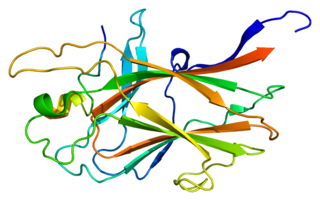Related Research Articles
Axon guidance is a subfield of neural development concerning the process by which neurons send out axons to reach their correct targets. Axons often follow very precise paths in the nervous system, and how they manage to find their way so accurately is an area of ongoing research.

Eph receptors are a group of receptors that are activated in response to binding with Eph receptor-interacting proteins (Ephrins). Ephs form the largest known subfamily of receptor tyrosine kinases (RTKs). Both Eph receptors and their corresponding ephrin ligands are membrane-bound proteins that require direct cell-cell interactions for Eph receptor activation. Eph/ephrin signaling has been implicated in the regulation of a host of processes critical to embryonic development including axon guidance, formation of tissue boundaries, cell migration, and segmentation. Additionally, Eph/ephrin signaling has recently been identified to play a critical role in the maintenance of several processes during adulthood including long-term potentiation, angiogenesis, and stem cell differentiation and cancer.

Ephrins are a family of proteins that serve as the ligands of the eph receptor. Eph receptors in turn compose the largest known subfamily of receptor protein-tyrosine kinases (RTKs).

Ephrin-B1 is a protein that in humans is encoded by the EFNB1 gene. It is a member of the ephrin family. The encoded protein is a type I membrane protein and a ligand of Eph-related receptor tyrosine kinases. It may play a role in cell adhesion and function in the development or maintenance of the nervous system.

EPH receptor A2 is a protein that in humans is encoded by the EPHA2 gene.

Ephrin type-B receptor 4 is a protein that in humans is encoded by the EPHB4 gene.

EPH receptor A4 is a protein that in humans is encoded by the EPHA4 gene.

Ephrin type-B receptor 1 is a protein that in humans is encoded by the EPHB1 gene.

EPH receptor A3 is a protein that in humans is encoded by the EPHA3 gene.

Ephrin type-B receptor 6 is a protein that in humans is encoded by the EPHB6 gene.

Ephrin type-A receptor 8 is a protein that in humans is encoded by the EPHA8 gene.

Ephrin type-A receptor 7 is a protein that in humans is encoded by the EPHA7 gene.

EPH receptor A5 is a protein that in humans is encoded by the EPHA5 gene.

Ephrin A4 is a protein that in humans is encoded by the EFNA4 gene.

Ephrin-A2 is a protein that in humans is encoded by the EFNA2 gene.

Ephrin A3 is a protein that in humans is encoded by the EFNA3 gene.

Ephrin-B3 is a protein that in humans is encoded by the EFNB3 gene.

EPH receptor A1 is a protein that in humans is encoded by the EPHA1 gene.

Ephrin type-B receptor 3 is a protein that in humans is encoded by the EPHB3 gene.

Ephrin A5 is a protein that in humans is encoded by the EFNA5 gene.
References
- ↑ Spacek J; Harris K. (April 2004). "Trans-endocytosis via spinules in adult rat hippocampus". J. Neurosci. 24 (17): 4233–4241. doi: 10.1523/JNEUROSCI.0287-04.2004 . PMC 6729277 . PMID 15115819.
- ↑ Lauterbach J; Klein R. (November 2006). "Release of full-length EphB2 receptors from hippocampal neurons to cocultured glial cells". J. Neurosci. 26 (45): 11575–11581. doi: 10.1523/JNEUROSCI.2697-06.2006 . PMC 6674799 . PMID 17093078.
- ↑ Krämer H. (April 2000). "RIPping notch apart: a new role for endocytosis in signal transduction?". Sci STKE. 2000 (29): 1pe–1. doi:10.1126/stke.2000.29.pe1. PMID 11752592. S2CID 33395895.
- ↑ Parks AL; Klueg KM; Stout JR; Muskavitch MA. (April 2000). "Ligand endocytosis drives receptor dissociation and activation in the Notch pathway". Development. 127 (7): 1373–1385. PMID 10704384.
- ↑ Klueg KM; Muskavitch MA. (October 1999). "Ligand-receptor interactions and trans-endocytosis of Delta, Serrate and Notch: members of the Notch signalling pathway in Drosophila". J Cell Sci. 112 (19): 3289–3297. PMID 10504334.
- ↑ Marston DJ; Dickinson S; Nobes CD. (October 2003). "Rac-dependent trans-endocytosis of ephrinBs regulates Eph-ephrin contact repulsion". Nat. Cell Biol. 5 (10): 879–888. doi:10.1038/ncb1044. PMID 12973357. S2CID 24717812.
| This cell biology article is a stub. You can help Wikipedia by expanding it. |